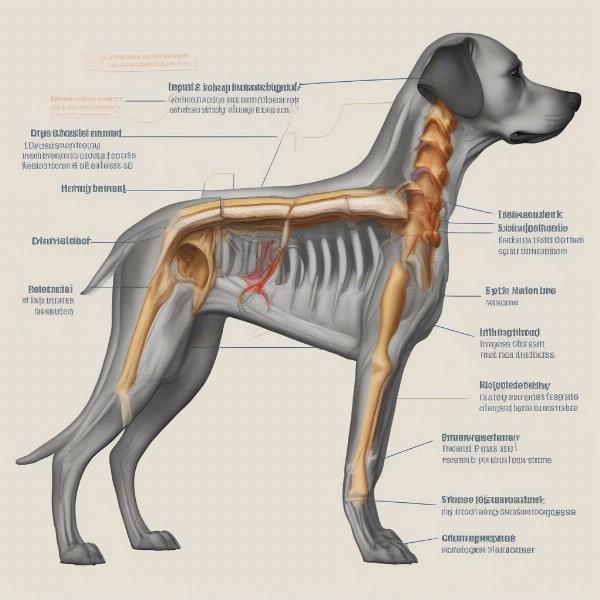Intervertebral disc disease (IVDD) is a painful condition affecting a dog’s spine. An ivdd dog brace can be a crucial tool in managing this condition, providing support, stability, and pain relief. This guide will delve into everything you need to know about ivdd dog braces, from understanding the different types available to choosing the right one for your furry friend.
Understanding IVDD and the Role of Braces
IVDD occurs when the cushioning discs between the vertebrae degenerate or rupture, putting pressure on the spinal cord. This can lead to pain, weakness, and even paralysis. An ivdd dog brace helps by supporting the spine, limiting movement, and reducing pressure on the affected area. This can significantly improve your dog’s comfort and mobility.  Diagram of a dog's spine affected by IVDD
Diagram of a dog's spine affected by IVDD
The use of a brace can be especially beneficial during the recovery period following surgery or conservative treatment. It helps stabilize the spine, promotes healing, and prevents further injury. It’s important to remember that a brace is not a cure for IVDD, but rather a management tool used in conjunction with other treatments as prescribed by your veterinarian.
Types of IVDD Dog Braces
There are various types of ivdd dog braces available, each designed for specific needs and levels of support. Some common types include:
- Rear leg braces: These braces support the hind legs and lower back, providing stability and assisting with mobility. They are commonly used for dogs with IVDD affecting the lower spine.
- Back braces: These braces provide support to the entire back, from the neck to the tail. They offer more comprehensive stabilization and can be helpful for dogs with more widespread IVDD.
- Neck braces: These braces are specifically designed to support the cervical spine (neck) and are used for dogs with IVDD affecting this area. They help limit neck movement and reduce pressure on the spinal cord.
Choosing the Right Brace for Your Dog
Selecting the appropriate ivdd dog brace is crucial for its effectiveness. Several factors should be considered, including:
- Severity of IVDD: The type and severity of your dog’s IVDD will determine the level of support required. A veterinarian can recommend the appropriate type of brace.
- Size and breed: Braces are designed to fit specific sizes and breeds, so accurate measurements are essential for a proper fit.
- Comfort and mobility: The brace should be comfortable for your dog to wear and allow for reasonable mobility.
- Material and durability: Choose a brace made from durable, breathable materials that can withstand regular use.
Using and Caring for an IVDD Dog Brace
Once you have chosen the right brace, proper usage and care are important. Your veterinarian will provide specific instructions on how to fit and apply the brace correctly.
It’s essential to monitor your dog for any signs of discomfort or skin irritation while wearing the brace. Regular cleaning and maintenance of the brace will ensure its longevity and hygiene.
Conclusion
An ivdd dog brace can be a valuable tool in managing IVDD and improving your dog’s quality of life. By understanding the different types of braces available, choosing the right one for your dog’s needs, and using it correctly, you can help provide your furry friend with the support and comfort they need to navigate this challenging condition. Remember to consult with your veterinarian for proper diagnosis and guidance on the best course of treatment for your dog’s specific situation.
FAQ
- How long will my dog need to wear the brace? This will depend on your dog’s individual case and the veterinarian’s recommendations. Some dogs may only need to wear the brace for a few weeks, while others may require long-term use.
- Can my dog sleep in the brace? Your veterinarian will advise you on whether your dog can sleep in the brace. In some cases, it may be necessary for support, while in others, it might be removed during rest.
- Are there any side effects of using an IVDD dog brace? Some dogs may experience minor skin irritation or discomfort initially. Proper fitting and monitoring are crucial to minimize these risks.
- How do I clean the brace? Follow the manufacturer’s instructions for cleaning. Most braces can be hand-washed with mild soap and water.
- Can I use a human back brace on my dog? No, human back braces are not designed for a dog’s anatomy and may not provide the necessary support. Always use a brace specifically designed for dogs.
- What are the signs that my dog might have IVDD? Signs can include pain, weakness, difficulty walking, a hunched back, and paralysis.
- How much does an ivdd dog brace cost? The cost can vary depending on the type and brand of brace. It’s best to discuss pricing options with your veterinarian.
cervical intervertebral disc disease dogs
cervical intervertebral disc disease in dogs
ILM Dog is your trusted resource for expert advice on all aspects of dog care and wellbeing. From breed selection to health and nutrition, training, grooming, and product recommendations, we provide comprehensive, practical information to help you provide the best possible care for your canine companion. For expert guidance tailored to your dog’s specific needs, contact us via email at [email protected] or phone at +44 20-3965-8624. ILM Dog is committed to helping you and your dog live a happy, healthy life together.